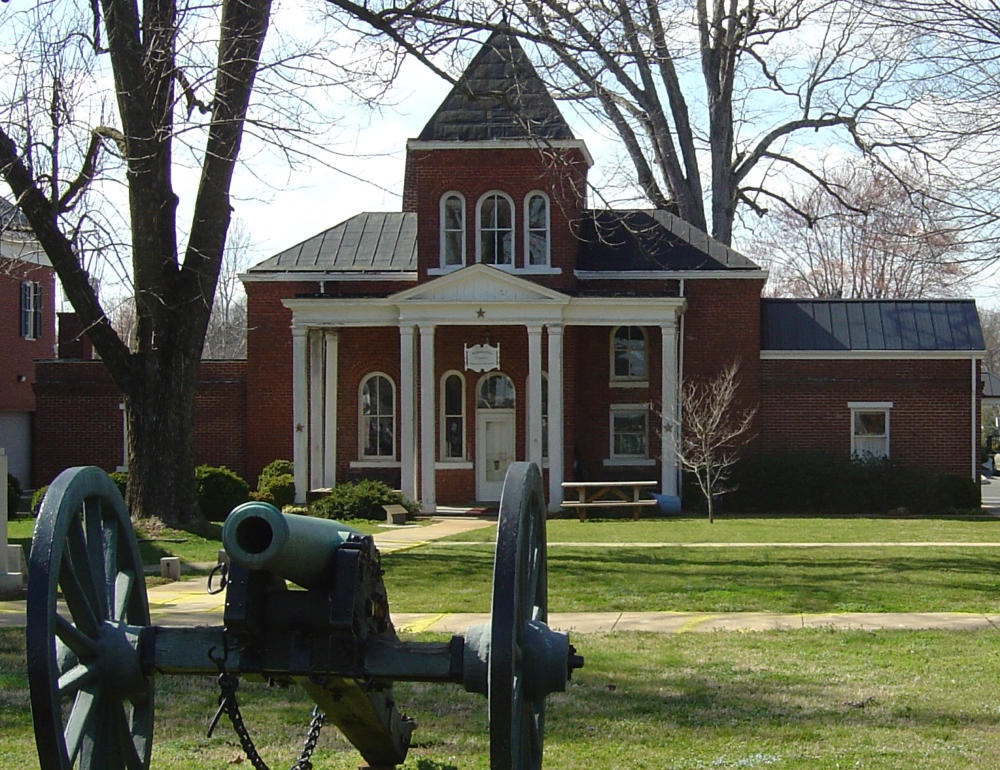 Old Jail Museum and Library
Old Jail Museum and Library
The Museum has been in constant operation under the management of the Society since the early 1980's. It is housed in the “third” Appomattox County Jail building that was built in 1895
and in use until May 1981 when a new courthouse and jail complex opened. The museum is located in courthouse square at 337 Court Street in the town of Appomattox.
A new addition to our museum building in 2016 was a genealogy and local history library that focuses on the people of Appomattox County and every aspect of their lives.
The museum and library is number 20 on the Appomattox Attractions map which can be downloaded as a .pdf file (click here).
Download an article on the history of Appomattox County jails (click here).
History
Appomattox County was formed in 1845 from parts of Buckingham, Campbell, Charlotte and Prince Edward counties. The county got its name from its earliest inhabitants, the Appomattox Indians.
The former stagecoach stop known as Clover Hill became the county seat and the village of Appomattox Court House. This area is now within our National Park.
The Court House remained there until 1892, when it was burned to the ground. Instead of rebuilding on the same location, the county officials decided to move the county seat two miles west,
to what then was the growing community of Nebraska, which had grown up around the railroad. Work was immediately begun in the building of a new Court House and Clerk's Office.
In 1895, a new jail was also begun and completed in 1897. It was the third jail to be built in Appomattox County. The first and second were built at the old court house (National Park) location.
There is part of the foundation of the first jail that has been marked by the park service. The second jail is still standing and is one of the buildings open at the park. The new third jail
was in continuous use until May 1981, when another new jail was completed just behind the old jail in Courthouse square.
In August 1981, the County Board of Supervisors turned part of the old jail building over to the Appomattox County Historical Society to be used as a museum. All articles that have been
collected and are displayed in the museum today have been contributed by the citizens of Appomattox County. These items were once owned and used by people formerly living here.
The rooms have been restored to show certain areas of life of the county around the turn of the century (1900).
The Civil War
The two rooms on the left of the front door depict the Civil War era. The first room has many items used by the soldiers in the Civil War. The second room is sponsored by the United Daughters
of the Confederacy. There are examples of Civil War monies, a quilt that belonged to Stonewall Jackson, a ladies dress of that era. There are also other Civil War items on display and a statue
that originally stood in the courtyard in front of the building.
The Jail Area
The jail cells have been restored to how they might have appeared in the early 1900's. The jailor and his family lived in the front part of this building and provided food and other care for
the prisoners. Medical attention was also provided. Doctors were called and medicine bought. New mattresses were the item most frequently purchased. Coffins were also bought and stored at the
jail to be used for prisoners who died.
Joe Sweeny Exhibit
The banjo is a replica of Joe Sweeney's. The original is in a California Museum. Joe Sweeney lived next to the old surrender grounds. His grave is near the bridge on park property.
Farm Items
The outside area to the right of the jail block has old farm items. Most of these are labeled. Old law books, etc. are behind the jail cell. There is a child's coffin on display. Coffins were
made at home. They were not opened if anyone died of a disease. Tobacco was the main money crop. There is a tobacco basket used for market, plug tobacco cutter and other tobacco items. To have
music you used the hand cranked victrola.
The Doctor's Office
This room contains books, pictures, diplomas, certifications and other medical paraphernalia belonging to former doctors practicing here. Note the exam table, sterilizer which are basically
the same as today and have been improved upon. Other items include the skull of the last man hung in Appomattox County, a chair used by Dr. Christian and pictures on the wall of doctors.
The Kitchen
Note items on the stove and in both pantries, also the water pump and shoo-fly.
the Indian Room
There are many artifacts in this room, including a number of which were from this area.
The School Room
The school room is a scaled down version of an actual school room. Most all of the furnishings were once used in one-room schools in Appomattox County. Many of the articles were given by
former teachers of one-room schools. Note the water bucket and dipper - children and teachers brought water from the spring. Teachers and children also brought in wood for the stove. There are
lunch pails and some articles of clothing. The black coat belonged to Chapman Hunter Chilton, who was superintendent of schools from 1870 - 1897. He was principal in 1860 at Union Academy in
Spout Spring.
The Nursery
There is an old cradle. Children had a nanny to look after them. There is a sewing machine, pictures of the town on the table and a Post Office desk from Vera. Note the names of some of the
customers still on the desk. There are also some old voting boxes.